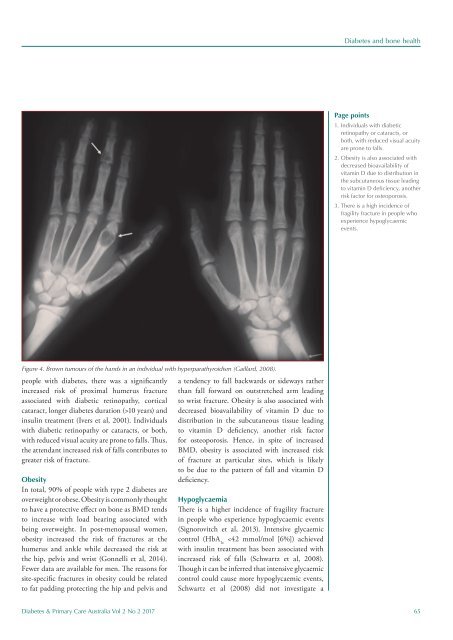DPCA2-2_issue_v3
You also want an ePaper? Increase the reach of your titles
YUMPU automatically turns print PDFs into web optimized ePapers that Google loves.
Diabetes and bone health<br />
Page points<br />
1. Individuals with diabetic<br />
retinopathy or cataracts, or<br />
both, with reduced visual acuity<br />
are prone to falls.<br />
2. Obesity is also associated with<br />
decreased bioavailability of<br />
vitamin D due to distribution in<br />
the subcutaneous t<strong>issue</strong> leading<br />
to vitamin D deficiency, another<br />
risk factor for osteoporosis.<br />
3. There is a high incidence of<br />
fragility fracture in people who<br />
experience hypoglycaemic<br />
events.<br />
Figure 4. Brown tumours of the hands in an individual with hyperparathyroidism (Gaillard, 2008).<br />
people with diabetes, there was a significantly<br />
increased risk of proximal humerus fracture<br />
associated with diabetic retinopathy, cortical<br />
cataract, longer diabetes duration (>10 years) and<br />
insulin treatment (Ivers et al, 2001). Individuals<br />
with diabetic retinopathy or cataracts, or both,<br />
with reduced visual acuity are prone to falls. Thus,<br />
the attendant increased risk of falls contributes to<br />
greater risk of fracture.<br />
Obesity<br />
In total, 90% of people with type 2 diabetes are<br />
overweight or obese. Obesity is commonly thought<br />
to have a protective effect on bone as BMD tends<br />
to increase with load bearing associated with<br />
being overweight. In post-menopausal women,<br />
obesity increased the risk of fractures at the<br />
humerus and ankle while decreased the risk at<br />
the hip, pelvis and wrist (Gonnelli et al, 2014).<br />
Fewer data are available for men. The reasons for<br />
site-specific fractures in obesity could be related<br />
to fat padding protecting the hip and pelvis and<br />
a tendency to fall backwards or sideways rather<br />
than fall forward on outstretched arm leading<br />
to wrist fracture. Obesity is also associated with<br />
decreased bioavailability of vitamin D due to<br />
distribution in the subcutaneous t<strong>issue</strong> leading<br />
to vitamin D deficiency, another risk factor<br />
for osteoporosis. Hence, in spite of increased<br />
BMD, obesity is associated with increased risk<br />
of fracture at particular sites, which is likely<br />
to be due to the pattern of fall and vitamin D<br />
deficiency.<br />
Hypoglycaemia<br />
There is a higher incidence of fragility fracture<br />
in people who experience hypoglycaemic events<br />
(Signorovitch et al, 2013). Intensive glycaemic<br />
control (HbA 1c<br />
















